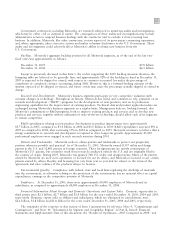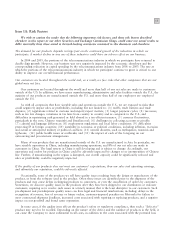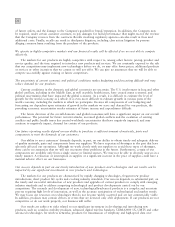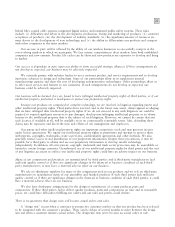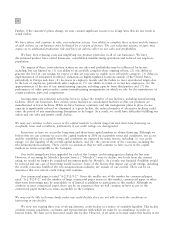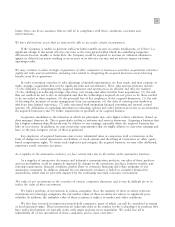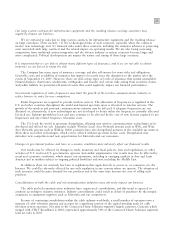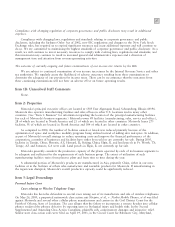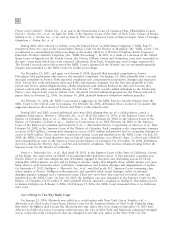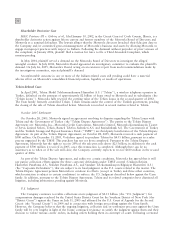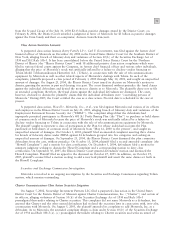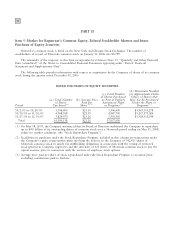Motorola 2005 Annual Report Download - page 33
Download and view the complete annual report
Please find page 33 of the 2005 Motorola annual report below. You can navigate through the pages in the report by either clicking on the pages listed below, or by using the keyword search tool below to find specific information within the annual report.
26
Sprint Nextel is our largest customer, representing 12% of the Company's net sales in 2005. On August 12,
2005, Sprint Corporation and Nextel Communications, Inc. completed their merger transaction that was announced
in December 2004. The combined company, Sprint Nextel, is the segment's largest customer and Motorola has
been its sole supplier of iDEN» handsets and core iDEN network infrastructure equipment for over ten years.
Fewer significant customers will increase our reliance on large customers and may negatively impact our
bargaining position and profit margins. The loss of, or a lesser role with, a significant customer due to industry
consolidation may negatively impact our business.
Regulatory changes impacting our cable products may adversely impact our business.
Currently, reception of digital television programming from the cable broadband network requires a set-top
box with certain technology. This security technology has limited the availability of set-top boxes to those
manufactured by a few cable network manufacturers, including Motorola. The FCC enacted regulations requiring
separation of security functionality from set-top boxes to increase competition and encourage the sale of set-top
boxes in the retail market. Traditionally, cable service providers sold or leased the set-top box to their customer. As
the retail market develops for set-top boxes and televisions capable of accepting the security modules, sales of our
set-top boxes may be negatively impacted.
The FCC has mandated that digital tuners to enable access to cable networks be incorporated into most
television sets by 2007. Such televisions can access certain cable programming without a digital set-top box. As a
result, future sales of set-top boxes may be negatively impacted.
We rely on complex information technology systems and networks to operate our business. Any significant system
or network disruption could have a material adverse impact on our operations, sales and operating results.
We rely on the efficient and uninterrupted operation of complex information technology systems and
networks. All information technology systems are potentially vulnerable to damage or interruption from a variety of
sources, including but not limited to computer viruses, security breach, energy blackouts, natural disasters,
terrorism, war and telecommunication failures. There also may be system or network disruptions if new or
upgraded business management systems are defective or are not installed properly. We have implemented various
measures to manage our risks related to system and network disruptions, but a system failure or security breach
could negatively impact our operations and financial results. In addition, we may incur additional costs to remedy
the damages caused by these disruptions or security breaches.
Our share price has been and may continue to be volatile.
Our share price has been volatile due, in part, to generally volatile securities markets, and the volatility in the
telecommunications and technology companies' securities markets in particular. Factors other than our financial
results that may affect our share price include, but are not limited to, market expectations of our performance,
capital spending plans of our customers, and the level of perceived growth in the industries in which we participate.
We rely on third-party distributors and retailers to sell certain of our products.
In addition to our own distribution force, we offer our products through a variety of third-party distributors
and retailers. Certain of our distributors market products that compete with the Company's products. The loss,
termination or failure of one or more of our distributors to effectively promote our products could affect the
Company's ability to bring its products to market. Changes in the financial or business condition of these
distributors and retailers could also subject the Company to losses.
The level of returns on pension and retirement plan assets could affect our earnings in future periods.
The funding obligations for our pension plans are impacted by the performance of the financial markets,
particularly the equity markets, and interest rates. Funding obligations are determined under ERISA and are
measured each year based on the value of assets and liabilities on a specific date. If the financial markets do not
provide the long-term returns that are expected under the ERISA funding calculation, we could be required to
make larger contributions. The equity markets can be, and recently have been, very volatile, and therefore our
estimate of future contribution requirements can change dramatically in relatively short periods of time. Similarly,
changes in interest rates can impact our contribution requirements. In a low interest rate environment, the
likelihood of required contributions in the future increases.



